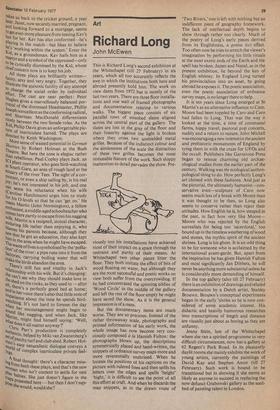Richard Long
John McEwen
This is Richard Long's second exhibition at the Whitechapel (till 27 February) in six years, which all too accurately reflects the awe in which the institutions both here and abroad presently hold him. The work on view dates from 1972 but is mostly of the last two years. There are three floor installations and one wall of framed photographs and documentation relating to various walks. The biggest piece consists of six parallel rows of smashed slates aligned across the central part of the gallery. The slates are lost in the grey of the floor and their linearity against the light is broken where they cross two unshielded metal grilles. Because of the indistinct colour and the aimlessness of the scale the distraction of these two grilles becomes the most noticeable feature of the work. Such sloppy inattention to detail pervades the show. Pre
viously too his installations have achieved most of their impact on a space through the restraint and purity of their means. At Whitechapel two other pieces litter the floor. They both imitate the effect of bits of wood floating on water, but although they are the most successful and poetic works on view both suffer from the overcrowding. If he had concentrated the spinning eddies of 'Wood Circle' in the middle of the gallery and left the rest of the floor empty he might have saved the show. As it is the general impression is of a mess.
But the documentary items are much worse. They are so precious. Instead of the rather throwaway scale, photographs and printed information of his early work, the whole image has now become very conciously composed a la Hamish Fulton: the photographs blown up, the descriptions symmetrically placed and hand-written, the snippets of ordnance survey maps more and more reverentially enshrined. When he locates the positions of his captions on the picture with rulered lines and then spills his letters over the edges and spells 'height' 'flight,' it is difficult to see the point of all this effort at craft. And when he discards the map snippets, as in the drawn route of
'Two Rivers,' one is left with nothing but an indifferent piece of geography homework.
The lack of intellectual depth begins to show through rather too clearly. Much of the poetry of Long's early pieces derived
from its Englishness, a genius loci effect.
Too often now he tries to stretch the viewer's imagination by performing his little rituals at the most exotic ends of the Earth and the spell has broken. Japan and Nepal, as in the present exhibition, lie beyond the ken of English whimsy. In England Long turned his provincialism into an asset, by going abroad he exposes it. The poetic association, even the poetic association of ordnance survey maps, is no longer there to help.
It is ten years since Long emerged at St Martin's as an alternative influence to Caro. Moore had been toppled by Caro and Caro had fallen to Long. That was the way it looked at the time, a time of communal farms, hippy travel, pastoral pop concerts, nudity and a return to nature. John Michell was encouraging a new interest in the ancient and prehistoric monuments of England by tying them in with the craze for UFOs and the occult. Publishers like Garnstone Press began to reissue charming old archaeological studies from the earlier part of the century. Walking was the ecological/anthropological thing to do. How perfectly Long's art chimed with these fashions. And just as the pictorial, the ultimately humanist—conservative even—sculpture of Caro now seems much less of a break with Moore than it was thought to be then, so Long also seems to conserve rather than reject their attitudes. How English he ig, how steeped in the past, in fact how very like Moore— Moore who was rejected by the English surrealists for being too 'sacerdotal,' too bound up in the timeless weathering of wood and stones, the mythic spirit of the ancient shrines. Long' is his ghost. It is an odd thing to be for someone who is acclaimed by the international avant-garde. But, apart from the inspiration he has given Hamish Fulton and most significantly Jan Dibbets, he will never be anything more substantial unless he is considerably more demanding of himself.
In the top gallery (also till 27 February) there is an exhibition of drawings and related documentation by a Dutch artist, Stanley Brouwn. Brouwn's conceptual experiments began in the early 'sixties so he is now con sidered of some academic interest. His didactic and heavily humorous researches into transcriptions of length and distance are visually just about as boring as they are unfunny.
Jenny Stein, late of the Whitechapel where she ran a spirited programme in very difficult circumstances, now has a gallery at 62 Regent's Park Road. In its pleasantly daylit rooms she mainly exhibits the work of young artists, currently the paintings of David Kay and Stephen Amor (till 27 February). Such work is bound to be transitional but in showing it she seems as likely as anyone to succeed in replacing the now defunct Grabowski gallery as the seedbed of painting talent in London.


































 Previous page
Previous page